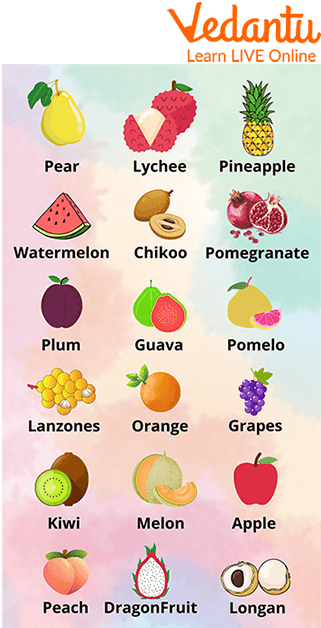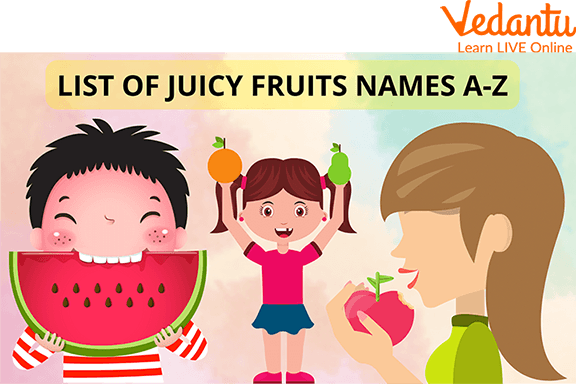




Top Juicy Fruits With High Water Content and Fun Facts
As you are aware, fruits play a significant and enticing role in your child's diet. In their first year of life, most newborns eat fruits and vegetables. However, many kids become pickier about particular meals, including fruits, as they become more self-sufficient eaters. Make sure to include as many fruits as necessary in your family's diet and enjoy them all together, since forcing kids to eat more fruits never works but it is important to set an excellent example by eating fruits yourself.
Everyone should consume fruits since they are full of vital minerals and vitamins that support children's growth, development, and overall health. This is true, especially for young children. In this article, we will discuss various small round fruits, their importance, and which fruits are beneficial to our health.

Multiple Small Round Fruits
Juicy Fruits Name List

Children Enjoying Eating Delicious Fruits
Below given is the juicy fruits name list:
1. Pineapple
Because it is a tropical plant, Filipinos frequently choose pineapple for their New Year's fruit bowl. The pineapple stands out among the other fruits in the bowl because of its golden hue from the inside out and its crowned top.
2. Orange
The orange is among the fruits that will stand out in your fruit bowl thanks to its vivid colour. The fruit is also thought to represent riches and luck in feng shui. In reality, the 8 Orange Tree, a miniature plant-like decoration with eight hanging oranges, is among the most well-liked feng shui ornaments. It is thought to bring prosperity to one's home.
3. Apple
A crimson apple is always a welcome sight for fruit lovers. This fruit, which frequently denotes good health, not only keeps the doctor away but also makes a wise addition to your Media Noche table list.
4. Grapes
Given that grapes are a fruit which blooms on vines in clusters or bunches of around 15, it is easy to understand why people believe they will bring abundance into their homes. It comes in a variety of hues, including purple, dark blue, yellow, green, and black.
5. Watermelon
Naturally, a full-grown watermelon would take up too much space on the table, therefore Filipinos who follow the tradition of the fruit bowl typically purchase the smaller varieties known as sugar baby watermelons. It has a milder flavour and a dark green rind compared to the large ones.
6. Melon
The cantaloupe is a common variety of melons with a light greenish exterior and a brilliant orange interior. It fits the criteria for your Media Noche table because of its extremely rounded shape, and this sweet delicacy is likely to be a light snack after the New Year.
7. Lychee
A round fruit with a thin rough skin and delicious white flesh encircling a big seed in the middle, the lychee is from the same family as the local rambutan. It tastes like a blend of grapes and pears and has a pleasant aroma. The red colour of this would match the occasion if you placed it in your fruit dish.
8. Kiwi
The kiwifruit, often known as the kiwi, is an oval-shaped fruit with a size comparable to a hen's egg. Its pale green flesh has a complex flavour and fibrous brown skin. It is creamy and luscious in texture, and many people describe it as tasting like a cross between strawberry, pineapple, and banana. I
9. Pomelo
The pomelo is a citrus fruit roughly the size of a cantaloupe. Its pulpy flesh is either pink or yellow, and it has a thick, yellow peel. The pomelo with the yellow centre is thought to be sweeter than the former, which frequently leans more toward the sour flavour.
10. Pear
The pear has an apple-like crisp feel and is a light yellow fruit. It has a pleasant flavour that gradually fades. The pear's silky peel looks attractive when arranged with the other fruits on your table.
11. Longan Fruit
If not for its tough shell, the longan fruit might initially be confused for lanzones. It features a black seed enclosed in the white flesh. While dried longans are utilised for Chinese food therapy and herbal medicine, longan fruits are also used in Asian soups.
12. Dragon Fruit
It should come as no surprise that the dragon fruit is thought to bring prosperity and good fortune to individuals given that dragons are seen as symbols of success and regal authority in Chinese Feng Shui. The fruit, which is spherical and bright pink with scaly spikes on the inside, is also referred to by the names pitaya, strawberry pear, and thang.
Practice Question
1Q. Name two fruits which are fleshy and juicy.
Ans: Mango and Orange are the names of two fruits which are fleshy and juicy.
Mango: The fruit called a mango is luscious and fleshy. Mangoes are a fruit with few calories, a lot of fibre, and a lot of vitamins A and C. Additionally, it has a small amount of calcium, vitamin E, zinc, folate, and B6.
Apple: The fruit known as orange is a variety of citrus trees of the Rutaceae family; the term is most often used to describe Citrus × Sinensis, also known as sweet orange, to distinguish it from the closely related Citrus × Aurantium, generally known as bitter orange.
Summary
From this article, we have gained a lot of information about various Fruits. Most fruits are bright in colour and sweet in taste. However, fruits are sometimes sour as well. There are many different types of small round fruits namely watermelon, melon, Pomegranate, Chico, Pear, Longan Fruit, Grapes, Apple and many others. These fruits are round-shaped and are very beneficial for our health in many ways. We hope now you know everything you need to know about these delicious fruits. In case of any other doubts feel free to ask in the comments.
FAQs on Juicy Fruits Names: Quick Guide to Healthy, Refreshing Fruits
1. What is the meaning of a 'juicy fruit'?
A juicy fruit is a type of fruit that is full of natural juice or liquid. When you bite into it or squeeze it, a lot of juice comes out. This high water content makes them very refreshing and hydrating. Good examples include oranges, watermelons, and grapes.
2. Can you list 10 common juicy fruits?
Certainly! Here is a list of 10 popular juicy fruits that are enjoyed for their refreshing taste:
Watermelon
Orange
Pineapple
Grapes
Strawberry
Mango
Peach
Lychee
Mosambi (Sweet Lime)
Tomato (which is botanically a fruit)
3. What is the importance of eating juicy fruits for our health?
Eating juicy fruits is very important for our health. Their high water content helps keep our bodies hydrated, which is essential for energy and overall function. They are also packed with essential vitamins and minerals like Vitamin C and potassium, which boost our immunity and keep us strong. The fibre in these fruits also helps in good digestion.
4. What are some examples of popular juicy fruits found in India?
India is home to many delicious juicy fruits that are very popular, especially during the summer. Some key examples include the Mango, known as the 'king of fruits'; Watermelon (Tarbooz), which is perfect for hot days; Lychee, a small, sweet fruit with a lot of juice; and various citrus fruits like Oranges (Santra) and Sweet Limes (Mosambi).
5. What is the main difference between a juicy fruit and a pulpy fruit?
The main difference lies in their texture and water content. Juicy fruits, like oranges or watermelons, have a very high liquid content that is released easily. Pulpy fruits, on the other hand, have thick, fleshy, and soft flesh (pulp) but less free-flowing juice. A good example of a pulpy fruit is a banana or an avocado. While mangoes can be both juicy and pulpy, the distinction helps in understanding fruit textures.
6. How does the high water content in juicy fruits specifically help our bodies?
The high water content in juicy fruits acts as a natural hydrator. This helps in several ways: it regulates body temperature, especially when it's hot outside; it helps transport nutrients to our cells; and it keeps our skin healthy and glowing. For young children and active people, eating these fruits is an easy and tasty way to stay hydrated without just drinking plain water.
7. Are all sweet-tasting fruits also juicy? Explain with an example.
No, not all sweet-tasting fruits are necessarily juicy. Sweetness and juiciness are two different characteristics. For instance, a fig or a date is very sweet but has a dense, chewy texture with very little juice. Conversely, a lemon is extremely juicy but has a sour taste, not a sweet one. This shows that a fruit's taste does not determine its water content.















